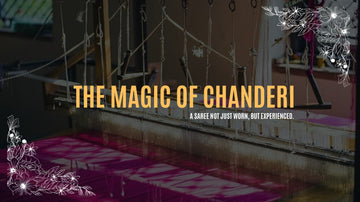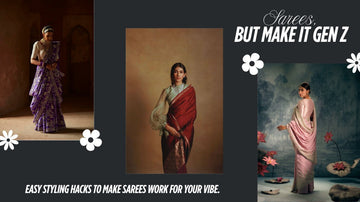The Weaving Techniques Behind Chanderi Sarees: A Blend of Tradition and Elegance
Chanderi sarees are a symbol of elegance, grace, and India’s rich handloom heritage. Originating from the charming town of Chanderi in Madhya Pradesh, these sarees are celebrated for their fine texture, airy quality, and luxurious feel. But what truly sets them apart is the unique weaving technique that has been perfected over centuries.
In this blog, we dive into the intricate weaving techniques behind Chanderi sarees and what makes them one of India’s most celebrated handloom treasures.
What is a Chanderi saree?
A Chanderi saree is a traditional Indian handloom saree known for its lightweight texture, glossy transparency, and intricate motifs. Originating from the town of Chanderi in Madhya Pradesh, this fabric is crafted using a unique blend of silk and fine cotton, often enhanced with zari (gold or silver thread) work. The hallmark of a Chanderi saree lies in its sheer quality—delicate yet durable, making it ideal for both everyday elegance and festive occasions.
The Traditional Weaving Process of Chanderi Sarees
The process of making Chanderi sarees requires a meticulous method that has been passed down through numerous generations of skilled artisans. It begins with the careful selection of yarns, typically pure silk, cotton, or a blend of both. These yarns are first softened by boiling, then dyed in vibrant colors using natural or synthetic dyes, and left to dry under the sun. Once the yarn is prepared, the warping process starts, where the lengthwise threads are stretched and aligned across the loom. Setting up the loom is a labor-intensive task and can take several days, depending on the intricacy of the design.
The actual weaving takes place on traditional pit looms, where the weaver sits slightly below ground level. One of the most distinctive aspects of Chanderi weaving is the creation of motifs, known as “buttis.” These motifs—ranging from florals and peacocks to coins and geometric patterns—are inserted using the extra-weft technique, which involves a separate shuttle for each motif, making each saree unique. Borders and motifs often incorporate real or imitation zari, adding a subtle shimmer and richness to the fabric. Despite the complexity, the saree retains its lightweight and sheer quality, making it both luxurious and comfortable to wear.
Why Chanderi Weaving is Unique
- Chanderi weaving combines silk and cotton yarns to create an unmatched lightweight texture.
- It uses a centuries-old extra-weft technique to weave motifs directly into the fabric.
- Every saree is completely handwoven using traditional pit looms by talented artisans.
- The transparency, or 'sheer' quality, of Chanderi fabric is a signature feature not easily replicated.
- Motifs such as peacocks, coins, and lotuses are inspired by nature and royal insignias.
- Authentic zari crafted from silver or gold threads imparts a royal luster to the creations.
- Weaving can take anywhere from a week to a month, depending on complexity.
- The town of Chanderi holds GI (Geographical Indication) status for this weaving tradition.
- Natural dyes and hand-dyeing methods preserve eco-friendly production values.
- No two sarees are identical—each one is a unique work of art.
- Chanderi fabric strikes a perfect balance between durability and elegance.
- Highly breathable and soft, making it ideal for both daily and festive wear.
The Cultural and Economic Importance
Chanderi weaving is more than just a craft—it is a cultural symbol and a vital economic engine for thousands of artisans in central India. Deeply rooted in the historical and spiritual fabric of the region, Chanderi sarees have long been associated with royalty, tradition, and religious significance. The motifs used in these sarees often draw inspiration from ancient temples, Mughal architecture, and nature, reflecting the region’s artistic richness and spiritual heritage.
Culturally, Chanderi sarees are an essential part of festive celebrations, weddings, and religious ceremonies across India. They are considered treasured family items, handed down over the years, representing a sense of continuity and heritage. Wearing a Chanderi saree is often seen as a symbol of elegance, refinement, and a deep respect for Indian traditions.
Modern Appeal of Chanderi Sarees
While rooted in history, Chanderi sarees have found a stronghold in contemporary fashion. Designers have reinterpreted the traditional weave into fusion silhouettes, minimalist designs, and pastel shades that cater to the modern palette. Today, Chanderi isn’t limited to sarees; it finds application in dresses, dupattas, lehengas, and even Western-inspired outfits, expanding its reach beyond conventional ethnic wear.
Celebrities, fashion influencers, and stylists across the globe have embraced Chanderi for its classic-meets-contemporary vibe. Whether it’s for weddings, festivals, or daily office wear, Chanderi offers versatility while upholding its artistic roots.
Final Thoughts
The weaving of a Chanderi saree is not just a textile process—it's a legacy passed down through generations. Every saree tells a story of skilled hands, deep-rooted tradition, and timeless beauty.
So the next time you wear a Chanderi saree, know that you’re not just wearing a garment—you’re draping history.









